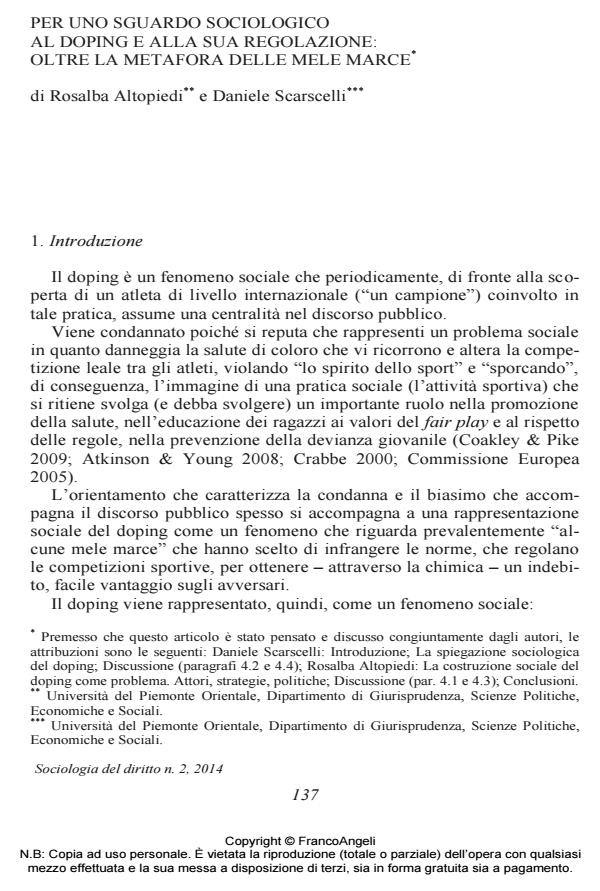Per uno sguardo sociologico al doping e alla sua regolazione: oltre la metafora delle mele marce
Titolo Rivista SOCIOLOGIA DEL DIRITTO
Autori/Curatori Rosalba Altopiedi, Daniele Scarscelli
Anno di pubblicazione 2015 Fascicolo 2014/2
Lingua Italiano Numero pagine 34 P. 137-165 Dimensione file 193 KB
DOI 10.3280/SD2014-002006
Il DOI è il codice a barre della proprietà intellettuale: per saperne di più
clicca qui
Qui sotto puoi vedere in anteprima la prima pagina di questo articolo.
Se questo articolo ti interessa, lo puoi acquistare (e scaricare in formato pdf) seguendo le facili indicazioni per acquistare il download credit. Acquista Download Credits per scaricare questo Articolo in formato PDF

FrancoAngeli è membro della Publishers International Linking Association, Inc (PILA)associazione indipendente e non profit per facilitare (attraverso i servizi tecnologici implementati da CrossRef.org) l’accesso degli studiosi ai contenuti digitali nelle pubblicazioni professionali e scientifiche
Il doping è un fenomeno sociale che periodicamente, di fronte alla scoperta di un atleta di livello internazionale ("un campione") coinvolto in tale pratica, assume una centralità nel discorso pubblico. Viene condannato poiché si reputa che rappresenti un problema sociale in quanto danneggia la salute di coloro che vi ricorrono e altera la competizione leale tra gli atleti, violando "lo spirito del- lo sport". L’orientamento che caratterizza la condanna e il biasimo che accompagna il discorso pubblico si basa spesso su una rappresentazione sociale del doping come fenomeno che riguarda prevalentemente "alcune mele marce". In realtà, nelle ultime due decadi la letteratura sociologica ha fornito numerose evidenze empiriche che ci consentono di affermare che il doping non riguarda soltanto "alcune mele marce" ma è fenomeno sociale che si è propagato dallo sport di élite a quello dilettantistico e al mondo delle palestre. Lo scopo di questo saggio è presentare le diverse spiegazioni sociologiche del doping, descrivere le forme di regolazione del fenomeno che si sono andate istituzionalizzando nel corso degli anni, individuando i modelli di spiegazione del fenomeno che sottostanno, spesso implicitamente, alle principali politiche di prevenzione e controllo, ed evidenziare alcune questioni critiche che tali forme di regolazione pongono a livello di tutela della salute, diritti e libertà civili e sull’efficacia stessa del controllo
Parole chiave:Sociologia dello sport - Doping - Approccio ‘Mele marce’ - Prevenzione - Deterrenza
- Come si diventa dopati Rosalba Altopiedi, Daniele Scarscelli, in Sociologia del diritto /2023
DOI: 10.54103/1972-5760/20578
Rosalba Altopiedi, Daniele Scarscelli, Per uno sguardo sociologico al doping e alla sua regolazione: oltre la metafora delle mele marce in "SOCIOLOGIA DEL DIRITTO " 2/2014, pp 137-165, DOI: 10.3280/SD2014-002006